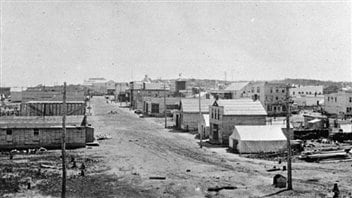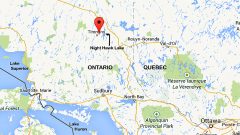It’s the gold rush you probably never heard of, but it was the biggest gold find in Canada by far.

While the Klondike gold rush is well-known, with its Yukon dance halls, and freezing hardships, June marks the anniversary of the start of the Porcupine Gold rush in Ontario some 105 years ago, in 1909
The town of Porcupine, is now considered part of Timmins, is about 800km NW of the national capital, Ottawa.

Red dot indicates South Porcupine and Porcupine Lake, about 48 km west of present-day Timmins, which is itself about 750km NW of Ottawa, the national capital. (google) CLICK to enlarge
The winters in northwestern Ontario bush were probably every bit as as bitter and cold as those of the Yukon, but in summer, the black flies and mosquitoes of the often swampy area in the region would have been maddening.
Nonetheless, in 1896 an Ontario government geologist reported finding quartz with gold traces just south of Porcupine, In 1900, another geologist, W.A. Parks, wrote, “I regard the region south of the trail to Porcupine Lake as giving promise of reward to the prospector.”

(photo circa 1915) The Temiskaming and Northern Ontario
Railway built a spur from Timmins to South Porcupine to service the growing demand of the gold mining industry.and the prospectors and mine employees coming to the area.
Prospectors moved into the area starting around 1902, with a couple of disappointing mines were set up around Night Hawk Lake a few years later.
There were still reports leaking out of the north about the potential of a big gold find and that attracted more people to try their luck.
In June 1909, Jack Wilson and a party of four prospectors and three aboriginal guides, went into the bush and came across a dome of quarts protruding out of the ground. He later wrote, “As I was examining the seams in the quartz, about twelve feet ahead of me I saw a piece of yellow glisten as the sun struck it. It proved to be a very spectacular piece of gold in a thin sean of schist… when the boys came back we got out the drills and hammers, and that night had about 132 pounds of very spectacular specimens.”
The rich vein of gold became the start of the Dome mine, the first of three major discoveries, and one that was quarried versus shafts in other mines to follow the gold-bearing quartz.
The next in the area came in October and became known as the Hollinger Mine after Benny Hollinger who discovered it, but later sold off his shares.
His partner Alex Gillies wrote of the discovery of a test pit abandoned three years earlier by a Reuben D’aigle who was a successful veteran of the Klondike rush, “Benny was pulling moss off the rocks a few feet away, when suddenly he let a roar out of him and threw his hat to me. At first I thought that he was crazy but when I came over to where he was it was not hard to find the reason. The quartz where he had taken off the moss looked as though someone had dripped a candle along it, but instead of wax it was gold.”
The final big mine was the McIntyre mine around Pearl Lake.
Unlike the Klondike, where placer type mining took place, the hard rock of the Canadian shield made it hard for individuals to develop mines, instead, the tens of thousands who came to the area ended up leaving relatively disappointed or working as employees for the big mining companies.
In terms of the gold-produced however, the Klondike is estimated to have produced 12 million troy ounces, the Porcupine region as of 2001 had produced 67 million troy ounces and is still producing.







For reasons beyond our control, and for an undetermined period of time, our comment section is now closed. However, our social networks remain open to your contributions.